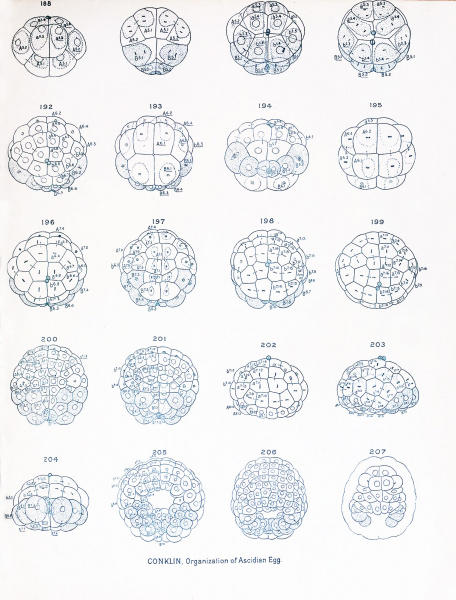File:Conklin 1905 plate12.jpg

Original file (1,521 × 2,000 pixels, file size: 639 KB, MIME type: image/jpeg)
Plate XII Whole Eggs of Ciona intestinalis - Sixteen Cells to Gastrula
Crescent substance stippled in nil the figures; clear protoplasm also stippled in figs. 188-191. Pobty bodies are actually present where drawn.
Fig. 188. Sixteen cell stage, anterior pole.
Fig. 189. Sixteen cells seen from vegetal pole; all but two of the cells are passing from the 5th to the 6th generation.
Fig. 190. Similar stage viewed from animal pole.
Fig. 191. Animal pole view, 5th to the 6th generation; 20 cells; when the divisions are completed, which are here indicated by spindles, there will be 32 cells.
Figs. 192-195. One and the same egg in the 32-cell-stage. Fig. 192. From animal pole. Fig. 193. From vegetal pole, spindles present in many of the cells, which are about to pass into the 7th generation. Fig. 194. From posterior pole; all nuclei at the animal pole in a resting condition. Fig. 195. Antero-vegetal view.
Figs. 196 and 197. One and the same egg seen from the animal (ventral) and from the vegetal (dorsal) poles; most of the cells at the vegetal pole have just passed into the 7th generation ; spindles are present in all the cells at the animal pole preparatory to their division into the 7th generation ; 44 cells, 20 of the 6th and 24 of the 7th generation.
Figs. 198-204. With the exception of fig. 199, all these figures represent views of one and the same egg. Fig. 198. View from animal pole showing all the ectoderm cells in process of division. Fig. 199. Another egg of the same stage as the preceding, but seen from a more anterior point of view. Fig. 200. Vegetal pole showing all the cells at this pole in a resting condition. Fig. 201. Same egg seen from a more anterior point of view. Fig. 202. Same egg viewed from the anterior pole. Fig. 203. Viewed from the right side showing in dotted outline the great elongation of the cells of the vegetal pole and a corresponding flattening of the cells at the animal pole. Fig. 204. Viewed from the posterior pole. 76 cells, viz., 32 ectoderm, !< endoderm, 18 mesoderm, 8 chorda, 8 neural plate; when the divisions indicated in the ectoderm cells are completed there will be 64 ectoderm cells and 108 cells in all.
Fig. 205. Gastrula corresponding in stage to fig. 140 of the Cynthia egg; 178 cells, vis., 108 ectoderm and neural plate (ventral), 20 endoderm, 18 mesenchyme, 12 muscle, 8 chorda, 12 neural plate (dorsal).
Fig. 206 and 207. Older gastrula with blastopore much restricted by the growth of the anterior lip Fig. 206. View of superficial ectoderm and mesoderm. Fig. 2(17. Deeper view of same embryo showing endoderm and mesoderm.
| Historic Disclaimer - information about historic embryology pages |
|---|
| Pages where the terms "Historic" (textbooks, papers, people, recommendations) appear on this site, and sections within pages where this disclaimer appears, indicate that the content and scientific understanding are specific to the time of publication. This means that while some scientific descriptions are still accurate, the terminology and interpretation of the developmental mechanisms reflect the understanding at the time of original publication and those of the preceding periods, these terms, interpretations and recommendations may not reflect our current scientific understanding. (More? Embryology History | Historic Embryology Papers) |
- Conklin Figures: Fig 1-2 | Fig 3-6 | Fig 7-8 | Fig 9-12 | Fig 13-16 | Fig 17-20 | Fig 21-24 | Fig 25-26 | Fig 27-33 | Fig 34-35 | Plate I | Plate II | Plate III | Plate IV | Plate V | Plate VI | Plate VII | Plate VIII | Plate IX | Plate X | Plate XI | Plate XII
Reference
Conklin EG. The Organization and Cell-Lineage of the Ascidian Egg (1905) J. Acad., Nat. Sci. Phila. 13, 1.
Conklin 1905 TOC: I. The Ovarian Egg | II. Maturation and Fertilization | III. Orientation of Egg and Embryo | IV. Cell-Lineage | V. Later Development | VI. Comparisons with A.mphioxus and Amphibia | VII. The Organization of the Egg | Summary | Literature Cited | Explanation of Figures
Cite this page: Hill, M.A. (2024, April 25) Embryology Conklin 1905 plate12.jpg. Retrieved from https://embryology.med.unsw.edu.au/embryology/index.php/File:Conklin_1905_plate12.jpg
- © Dr Mark Hill 2024, UNSW Embryology ISBN: 978 0 7334 2609 4 - UNSW CRICOS Provider Code No. 00098G
File history
Click on a date/time to view the file as it appeared at that time.
| Date/Time | Thumbnail | Dimensions | User | Comment | |
|---|---|---|---|---|---|
| current | 16:48, 19 October 2016 |  | 1,521 × 2,000 (639 KB) | Z8600021 (talk | contribs) | {{Historic Disclaimer}} {{Conklin1905 figures}} ===Reference=== {{Ref-Conklin1905}} {{Conklin1905 TOC}} {{Footer}} |
You cannot overwrite this file.
File usage
The following 2 pages use this file:
